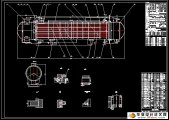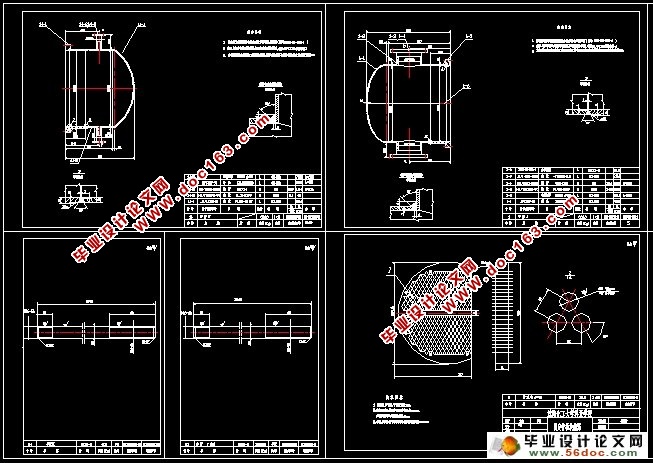流量为260t/h卧式蒸汽冷凝器(含CAD零件装配图)

流量为260t/h卧式蒸汽冷凝器(含CAD零件装配图)(设计说明书10300字,文献综述,CAD图纸11张)
摘要
换热器又被叫热量交换器,是一种把热流体的热量传递给冷流体的设备,并且实现化工生产过程中热量的交换和传递不可缺少的设备,在工厂中具有重要的意义。换热器可以是一种单独的设备,例如加热器、冷却器和凝汽器等等;也可是工艺设备的组成部分,比如石化、煤炭工业中的余热回收装置等等。换热器是两种温度不同的物料在一个设备内相互交换热量,最终达到将物料冷却,或者将冷物料加热为目的的设备。本换热器是蒸汽冷凝器在成产中是非常常见的设备,该换热器有耐高压的优点、价格低廉、清洗方便不宜结垢的优点。
已知条件为:设计压力为管程 ,壳程 ,工作温度管程 ,壳程 ,设计温度管程 ,壳程 ,管程介质为 的水,壳程介质为 的水蒸气。依据给定条件所得传热面积为 。考虑到介质特性等因素,采用Φ25×2.5×4500的 (材料)的无缝钢管,本设计采用390根换热管可满足换热量。设定拉杆数量为6根,计算得到筒体直径为
。完成了压降计算、强度计算、开孔补强、管箱短节壁厚计算等。在强度设计中,依据 进行筒体、封头强度设计及校核,依据流量进行入口接管、出口接管等管口直径的选择,依据等面积补强法进行开口补强计算。本设计选择管板延长兼做法兰,依据 中的弹性支撑假设对管板进行设计和校核,管板与换热管的连接方式为焊接,拉杆与管板为螺纹连接结构。同时,进行了卧式容器鞍座校核。
[来源:http://Doc163.com]
本设计充分的利用材料,适用比较多的场合。390根换热管更加体现了换热的效率。在同样的换热器中此换热器十分的廉价、安全。所以该换热器在工厂中占有重要位置。
关键字: 固定管板; 换热器; 不同物料; 热交换 ;补强
Abstract
Heat exchanger called heat exchanger again, it is a kind of the thermal fluid heat transfer to cold fluid equipment, and realize the heat exchange and transmission in the process of chemical production indispensable equipment, has the vital significance in the factory. Heat exchanger can be a single device, such as a heater, cooler and steam condenser, etc. But also part of the process equipment, such as waste heat recovery unit in petrochemical industry, coal industry, and so on. Temperature heat exchanger are two different materials in a heat exchanging equipment, eventually achieve the material cooling, or heating equipment for the purpose of cold material. This heat exchanger is steam condenser is very common in into during equipment, the heat exchanger has the advantages of resistance to high pressure, low cost, convenient cleaning is unfavorable and scale advantages. [来源:http://www.doc163.com]
Known condition is: the design pressure for tube side and shell side, working temperature tube side and shell side, the design temperature tube side and shell side, the medium as the water passes, shell side medium is water vapor. Based on the heat transfer area of the given conditions. Considering the characteristic of medium etc factors, using (material) seamless steel tube, this design USES the root heat exchange tube can meet the change of heat. Set rod of 6 root number, calculate the cylinder diameter. Completed the pressure drop calculation, strength calculation, opening reinforcement, short tube box section wall thickness calculation, etc. In strength design, strength design basis for cylinder, head and checking, according to the inlet connection of traffic and exports over the selection of nozzle diameter, opening reinforcement method on the basis of equal area reinforcement calculation. The design of flange, tubesheet extended and do according to the hypothesis of elastic support for tube plate design and checking, tube plate and the heat exchange tube connections for welding, rod and tube plate to the threaded connection structure. At the same time, for the horizontal vessel saddle checking. [资料来源:http://doc163.com]
This design make full use of material, is more occasions. 608 more embodies the heat exchange tube, so the heat exchange efficiency. At the same heat exchanger in the heat exchanger is very cheap and safe. So the heat exchanger occupies an important position in the factory.
Key words: Fixed tube sheet; Heat exchanger; Different materials; reinforcing
[资料来源:http://Doc163.com]



1.1原始数据
管程水的进口温度 =20℃
管程水的出口温度 =85℃
管程水的工作压力 =2.2MPa
管程水的流量 =260000kg/h
壳程水蒸气的入口温度 =164.97℃
壳程水蒸气的出口温度 =80℃
壳程水蒸气的工作压力 =0.7MPa
1.2定性温度及确定其物性参数
管程水的定性温度
管程水密度查物性表得
管程水比热查物性表得
管程水导热系数查物性表得 =0.6557w/(m•℃)
管程水黏度 =5.229×10-4pa•s
管程水普朗特数查物性表得Pr1=2.96
壳程水蒸气定性温度
壳程水蒸气冷凝点:
冷却段:
冷凝段:
壳程水蒸汽密度查物性表得:
冷却段: =943.4kg/m³
冷凝段: =4.122kg/m³
壳程水蒸汽比热查物性表得:
冷却段: =4.258KJ/(kg•℃)
冷凝段: =2.583KJ/(kg•℃)
壳程水蒸汽导热系数查物性表得:
冷却段:λ2=0.688w/(m•℃)
冷凝段: =0.0313w/(m•℃)
目 录
第一章换热器传热工艺计算 1
1.1原始数据 1
1.2定性温度及确定其物性参数 1
1.3传热量与水蒸气流量计算 2
1.4有效平均温差计算 3
1.5管程换热系数计算 4
1.6 结构的初步设计 5 [资料来源:www.doc163.com]
1.7壳程换热系数计算 6
1.8 总传热系数计算 7
1.9 管壁温度计算 8
1.10 管程压力降计算 8
1.11 壳程压力降计算 9
第二章固定管板式换热器结构设计计算 12
2.1 换热管材料及规格的选择和根数的确定 12
2.2 布管方式的选择 12
2.3 筒体内径的确定 13
2.4 筒体壁厚的确定 13
2.5 筒体水压试验 14
2.6 封头厚度的确定 14
2.7 管箱短节壁厚计算 15
2.8 管箱水压试验 16
2.9 管箱法兰的选择 16
2.10 管板尺寸的确定及强度计算 17
2.11 是否安装膨胀节的判定 30
2.12 防冲板尺寸的确定 30
2.13 折流板尺寸的确定 31
2.14 各管孔接管及其法兰的选择 32 [版权所有:http://DOC163.com]
2.15 开孔补强计算 37
2.16 支座的选择及应力校核 40
2.16.1 支座选择 40
2.16.2 鞍座的应力校核 40
参考文献 45
致谢 46
[版权所有:http://DOC163.com]
